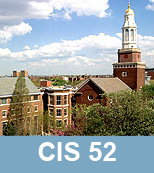

Course Outline
- I. Introduction
- A. Uses of multimedia information
- B. Historical background
- II. Survey of hardware
- A. Graphic boards and accelerators
- B. Sound boards
- C. Video capture boards
- D. Magnetic and optical storage devices
- E. DVD. Blu-Ray, HD-DV (macrovision, VCDs, SVCDs, VOBs, ripping techniques)
- III. Survey of software
- A. Graphic standards
- B. Music computer formats
- C. Video computer standards
- D. Gaming
- E. Authoring Systems
- IV. Multimedia Platforms (QuickTime, MCI, Video for Windows, Activemovie, Direct-X)
- V. Multimedia Programming (Java, Active-X, MCI, Windows Foundation Classes)
- VI. The creative process: hardware, software, development team and methodology
- VII. Media Types – Media Objects (Implementations and methods)
- A. Text
- 1. Encoding – ASCII, Unicode
- 2. Formatting – in-line (.dot notation, HTML, SGML)
- 3. Page description languages – Adobe pdf
- B. Image
- 1. Bit mapped vs. vector based representations
- 2. Color Space Representations – RGB, CMY, HSU
- 3. CLUTs
- 4. Color depth and resolution
- 5. Image File Formats BMP, GIF, JPEG, PNG, TIFF
- 6. Editing tools and effects (pixel methods, masking, morphing, etc.)
- C. Graphics – Internal and external modeling techniques, mapping, lighting, viewing and rendering
- D. Audio
- 1. The physics of sound
- 2. Sound fields, the environment and acoustics – multi-channel/surround sound
- 3. Quantization and sampling rate
- 4. The Nyquist theorem
- 5. Audio formats
- 6. Digital encoding (PCM, ADPCM, A-law/m-law
- 7. Digital Audio Effects & Filtering
- E. Music – MIDI, SMDL
- F. Video – analog, digital and broadcast
- 1. Luminance and Chrominance representations
- 2. Fields, frames and interlacing
- 3. Color encoding (Camera, transmission and receiver: RGB, YUV, YIQ, YCbCr)
- 4. RF, Composite, S-Video and Component video
- 5. NTSC and HDTV
- 6. Editing techniques (traditional vs. NLE systems)
- 7. Transitions, keying, and scaling
- 8. Storage and distribution
- G. Animation – Modeling & Rendering
- H. Video Conferencing
- I. Other Media types (speech, digital ink, virtual reality)
- A. Text
- VIII. Multimedia and the Internet
- A. WWW
- B. Web browsers
- C. HTML, VRML, CGI, Active-X and Java
- IX. System survey (multimedia examples taken from science, entertainment, gaming, etc.)
- X. Design issues
- A. System design issues
- B. Implementation issues
- C. Usability evaluation
- XI. Compression Techniques
- A. Requirements
- B. Basic information theory
- 1. Entropy vs. energy
- 2. Shannon’s equation
- 3. Entropy vs. source encoding
- C. General Purpose compression algorithms
- 1. Run Length Encoding
- 2. Relative Encoding
- 3. Huffman Coding
- 4. Arithmetic Coding
- 5. Lempel-Ziv Coding
- D. Intraframe compression algorithms
- 1. Sub-sampling
- 2. Course quantization
- 3. Vector quantization
- 4. Transform encoding
- E. Interframe Compression algorithms
- 1. Sub-sampling
- 2. Difference coding
- 3. Block based difference coding
- 4. Block based notion compensation
- F. JPEG and the DCT
- G. MPEG file structure and I-, P-, B-frames
- H. Practical compression techniques
- 1. mp3,
- 2. DivX, MPEG-4
Outline.doc(01/18/08)

